|
|
|
|
|
|
Rifles, Shotguns, Checkering Alternatives
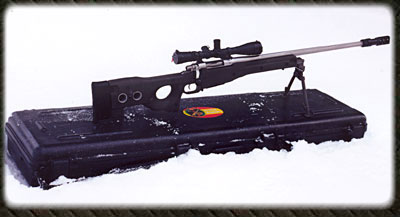
There are a lot of places that are more specialized than I am in certain kinds of long gun work, and without reservation I will tell you that some of them will be able to do certain things better and/or for less. But, I believe you will see some things here that are not offered elsewhere. When you want something that nobody else is doing or will consider doing, or doesn't think can be done, maybe I can help.
Shotguns-The Browning BPS has never been seen as a fighting or action
competition shotgun. That's a shame, because with a few modifications,
it makes a great one. When I needed to upgrade to a modern pump from the
Winchester '97, I looked at everything I could find. I looked outside
the boundaries, being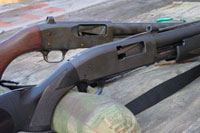 careful to not be
constrained by what everybody else was using. My three main criteria
were handling related: a) it must have a short, smooth stroke; b) ergos
must be good- safety and slide release easily reached and actuated; c)
there must be no %#&%$@#!!)&$# cartridge lifter, acting as a loading
gate to the magazine. As popular as certain models of shotgun are, many
have the lifter/gate which must be depressed to load the magazine. These
tend to act like Chinese fingercuffs, trying to skin the unfortunate
thumb that follows a little too closely behind the cartridge it is
pushing in. The BPS has none, and, in fact, the magazine loading area is
long enough that loading two at a time is possible, by dropping a
cartridge on to the bottom of the bolt of the overturned shotgun,
careful to not be
constrained by what everybody else was using. My three main criteria
were handling related: a) it must have a short, smooth stroke; b) ergos
must be good- safety and slide release easily reached and actuated; c)
there must be no %#&%$@#!!)&$# cartridge lifter, acting as a loading
gate to the magazine. As popular as certain models of shotgun are, many
have the lifter/gate which must be depressed to load the magazine. These
tend to act like Chinese fingercuffs, trying to skin the unfortunate
thumb that follows a little too closely behind the cartridge it is
pushing in. The BPS has none, and, in fact, the magazine loading area is
long enough that loading two at a time is possible, by dropping a
cartridge on to the bottom of the bolt of the overturned shotgun,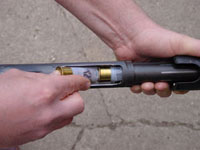 pushing it in with a second cartridge, which then
follows it in. You have just loaded two for the price of one, so to
speak. As a bonus, the BPS has an ambidextrous safety, if that is
important to you. It also has bottom ejection, of which much is made,
but the advantage is not that the empties come out the bottom, nor even
that the receiver is enclosed (although I'll admit that doesn't hurt).
The real advantage is that ejection is very positive and it is not
necessary that the slide be racked hard and fast to get clean ejection.
The one huge, glaring disadvantage of the BPS and other bottom-ejecting
shotguns in a fighting/competition role, is that a single round cannot
be quick-loaded into the chamber when the gun runs dry, as there is no
ejection port giving the shooter direct access to the chamber. The
action of the gun must be closed, a round loaded into the magazine, and
racked into the chamber-- slow and cumbersome. Some tactical trainers
recommend against the habit of dropping a round directly into the
chamber because a) you weren't supposed to let the gun run dry in the
first place, and b) you are using two loading procedures: one for an
empty gun and one for a partially loaded one. Be that as it may, when
the shotgun has been run dry, and you have just heard that very loud
CLICK, it is faster to drop one in with the action open and close it
than it is to put one in the magazine and rack it in. There could be a
time when one round NOW is more meaningful that one round in
"now-point-eight" seconds with the satisfaction that you did it like
they told you. Toward this end, the BPS and the Ithaca Model 37 pictured
here have the loading port cut into the receiver.
pushing it in with a second cartridge, which then
follows it in. You have just loaded two for the price of one, so to
speak. As a bonus, the BPS has an ambidextrous safety, if that is
important to you. It also has bottom ejection, of which much is made,
but the advantage is not that the empties come out the bottom, nor even
that the receiver is enclosed (although I'll admit that doesn't hurt).
The real advantage is that ejection is very positive and it is not
necessary that the slide be racked hard and fast to get clean ejection.
The one huge, glaring disadvantage of the BPS and other bottom-ejecting
shotguns in a fighting/competition role, is that a single round cannot
be quick-loaded into the chamber when the gun runs dry, as there is no
ejection port giving the shooter direct access to the chamber. The
action of the gun must be closed, a round loaded into the magazine, and
racked into the chamber-- slow and cumbersome. Some tactical trainers
recommend against the habit of dropping a round directly into the
chamber because a) you weren't supposed to let the gun run dry in the
first place, and b) you are using two loading procedures: one for an
empty gun and one for a partially loaded one. Be that as it may, when
the shotgun has been run dry, and you have just heard that very loud
CLICK, it is faster to drop one in with the action open and close it
than it is to put one in the magazine and rack it in. There could be a
time when one round NOW is more meaningful that one round in
"now-point-eight" seconds with the satisfaction that you did it like
they told you. Toward this end, the BPS and the Ithaca Model 37 pictured
here have the loading port cut into the receiver.
Some other odds and ends...not things I've done dozens of, but again, examples that show the limits may be a little further out than you thought; just because there is not a product in somebody's catalog, or just because you haven't seen it done before, does not mean it can't be done.
Picture 4: Ruger 10/22 with left-hand cocking knob and trigger-finger-tip mag release.
Picture 5: Pop-up tritium sight for AR-15. Standard night sights for these are too wide for a fine sight picture. With this you can stow the night sight and use the thin front sight for precise, daylight shooting, or pop the night sight up - it is detented in both positions.
Picture 6: Trigger-finger safety for Kalashnikov. Helps with the horrible ergonomics of manipulating the safety on these otherwise decent rifles. This one also has a notch in the safety lever and cocking handle that work together as a bolt hold-open.
Picture 7: Muzzle brake for bolt guns. This attaches without threading the barrel, removing the possibility of collapsing the bore by over-tightening. Easy on and off and very effective.
Pictures 8 and 9: Brakes machined directly into the barrel- two AR15's in this case.
 |
 |
 |
| Picture 4 | Picture 5 | Picture 6 |
 |
 |
 |
| Picture 7 | Picture 8 | Picture 9 |
Checkering Alternatives
Checkering is classic, and it works, but it is not the only option. Picture "A"
shows what I call Conamyds. This treatment gives a very solid grip, but the amount
of traction is more proportional to the amount of pressure you exert in grasping
the pistol.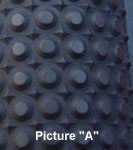
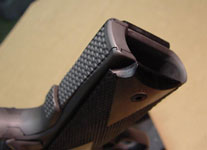 That is, you are not committed
to an improper grasp if your draw is imperfect, like you might be with very sharp
60-degree checkering. You can loosen the grasp and get everything where it needs to
be; you're not stuck. But, with a normal firing grasp, you are locked in and stable.
Another advantage to this form is that, unlike checkering, there are no 90- or
60-degree V's, which in some cases could promote cracking and failure. I have never
seen this happen in a properly done checkering job, but, if for some reason things
should get too thin, it definitely could happen. On a 1911 frontstrap, for example,
whose thickness was towards the low end, say .055, a checkering job of 20 LPI at
60 degrees would theoretically leave you with a frontstrap held together by .012
bands of metal. Not enough. Conamyds are .010 to .020 deep, depending on the amount
of sticktion desired, frontstrap thickness, and frame material.
That is, you are not committed
to an improper grasp if your draw is imperfect, like you might be with very sharp
60-degree checkering. You can loosen the grasp and get everything where it needs to
be; you're not stuck. But, with a normal firing grasp, you are locked in and stable.
Another advantage to this form is that, unlike checkering, there are no 90- or
60-degree V's, which in some cases could promote cracking and failure. I have never
seen this happen in a properly done checkering job, but, if for some reason things
should get too thin, it definitely could happen. On a 1911 frontstrap, for example,
whose thickness was towards the low end, say .055, a checkering job of 20 LPI at
60 degrees would theoretically leave you with a frontstrap held together by .012
bands of metal. Not enough. Conamyds are .010 to .020 deep, depending on the amount
of sticktion desired, frontstrap thickness, and frame material.
Shallowmyds (Picture "B") are another alternative,
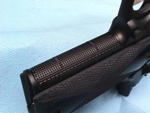 developed specifically for thin-frontstrap
conditions, especially on aluminum frames. Even with a loupe, it can be
difficult to tell them from regular 90-degree checkering, but they are
only half the depth. What makes them work is that they are still
pointed, at 90 degrees, but the valleys are radiused. They give about
85% of the traction of regular 90 degree checkering. You can picture
Shallowmyds this way: you are standing in the Egyptian desert, in front
of a row of pyramids which are touching at the base. You take a long
rope and go to the top of each one, and when you're done, that rope is
draped over the peak of each one, but sags exactly halfway to the ground
between pyramids. Go back to your original vantage point and look--
that rope is now a line describing Shallowmyd geometry.
developed specifically for thin-frontstrap
conditions, especially on aluminum frames. Even with a loupe, it can be
difficult to tell them from regular 90-degree checkering, but they are
only half the depth. What makes them work is that they are still
pointed, at 90 degrees, but the valleys are radiused. They give about
85% of the traction of regular 90 degree checkering. You can picture
Shallowmyds this way: you are standing in the Egyptian desert, in front
of a row of pyramids which are touching at the base. You take a long
rope and go to the top of each one, and when you're done, that rope is
draped over the peak of each one, but sags exactly halfway to the ground
between pyramids. Go back to your original vantage point and look--
that rope is now a line describing Shallowmyd geometry.
Any of the patterns I do can be applied to the backstrap as well, and depending on your personal tastes can be run upward to cover the memory-bump area of a 1911's grip safety, and run off the sides of the mainspring housing onto the frame. The Conamyd job pictured has both. This gun reflects my personal liking for a slender 1911 lower frame; the mainspring housing has been re-angled and reduced as much as possible. The side-to-side radius is larger, giving a flatter surface side-to-side. This gives the hand more "wrap" on the pistol and more area for a positive purchase. People with larger than average hands might not get any benefit from this.